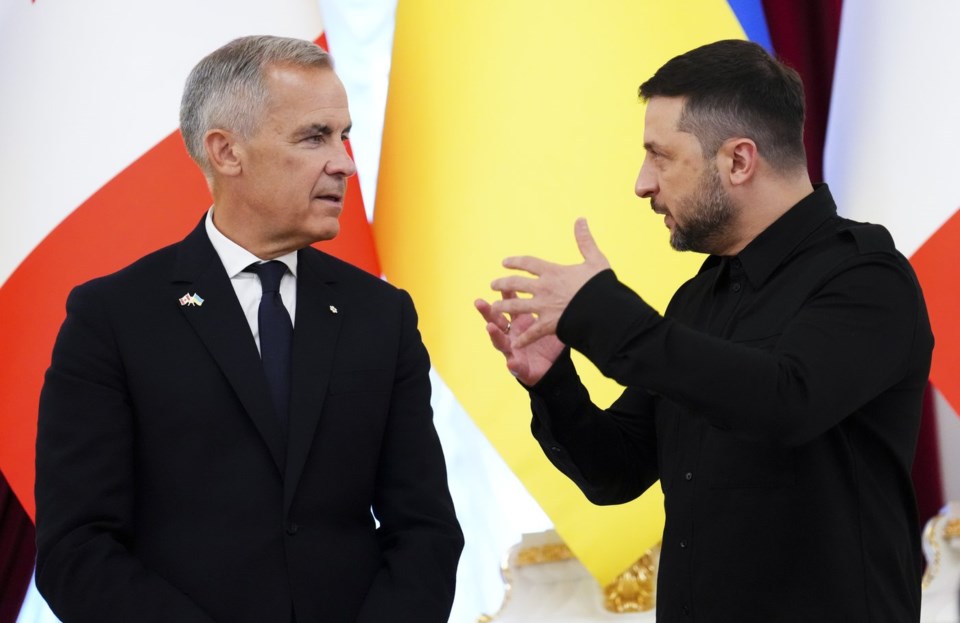After Prime Minister Mark Carney's surprise visit to Ukraine this past weekend, criticism of the nearly $22 billion in assistance Canada has pledged to the country so far spread on social media, along with misunderstandings about what's included in the aid package. Some of the criticism pointed to a news release from the Prime Minister's Office erroneously stating Canada has made "the highest per capita contribution among G7 countries." In fact, while Canada contributed the most direct financial supports per capita among G7 countries, it has not contributed the most in total.
THE CLAIMS
"Since the start of Russia’s full-scale invasion in February 2022, Canada has committed nearly $22 billion in multi-faceted assistance for Ukraine – the highest per capita contribution among G7 countries," the Prime Minister's Office said in a news release that coincided with Ukraine’s Independence Day on Sunday and Prime Minister Mark Carney's visit to the region.
The news release was used by some on social media to criticize the funding commitments made by Canada, with one post with more than 2,000 likes on the X platform, formerly Twitter, describing the $22 billion as "donated" by Canada, and another with more than 4,000 likes implying Canada is the largest donor overall per capita.
An image shared more than 2,000 times on Facebook and posted on Aug. 18, before Carney's trip, made the same claim about Canada sending "more than any other country on a per-capita basis" to Ukraine since Russia invaded the country in 2022.
THE FACTS
While Canada has contributed more direct financial assistance to Ukraine than any country in the G7 per capita, it has not spent the most in total.
Canada has committed slightly more than $12.3 billion in direct financial assistance to Ukraine, which, with an estimated population of 41.55 million people, works out to about $296 per person in Canada.
The United States has committed about US$56.95 billion, or C$78.3 billion, in financial assistance, according to Germany's Kiel Institute for the World Economy, a think tank that tracks the aid data. With a population of roughly 342.38 million people, that works out to C$229 per person in the United States. (Kiel Institute reports in euros and U.S. dollars; all figures are at Thursday's exchange rates.)
The Prime Minister's Office had previously correctly said that Canada's direct financial assistance to Ukraine was the highest in the G7 on a per-capita basis, and the news release from Aug. 24 has since been changed to say the same thing.
In total, Canada has committed nearly $22 billion in aid to Ukraine, including military, humanitarian and development assistance.
That's about $529 per person, but G7 member the United States has committed about US135.61 billion (C$186.4 billion) in total, or about C$544 per person.
Other countries not in the G7 have committed more funding than both Canada and the United States per capita, including Norway ($31.1 billion, or $5,554 per capita) and Denmark ($15.9 billion, or $2,650 per capita), according to Kiel Institute figures and most-recent population counts.
MILITARY, HUMANITARIAN FUNDS AND LOANS
Canada's funding commitments include direct financial assistance as well as funds for military, humanitarian, development and other needs — but not all of those funds have been disbursed, and almost all of the direct financial assistance is in the form of loans.
The Canadian government says it has committed $6.5 billion in military assistance through 2029, including the $2 billion announced at the G7 Summit in Alberta in June, to be used for things such as armoured vehicles, drones and other munitions.
Additionally, Canada has committed $372.2 million in humanitarian funding, covering emergency health services, protection and support to displaced populations, and $700 million in development assistance, which the government says includes things like addressing the needs of victims of sexual and gender-based violence, supporting mental health, agriculture and energy.
About $12.1 billion of the of the $12.3 billion in financial assistance Canada has committed to Ukraine is in the form of loans, most of which come to maturity 10 years after their issue date. Of that figure, $4.8 billion is part of a plan called the Extraordinary Revenue Acceleration mechanism announced in June 2024, which uses the interest on frozen Russian assets to secure a U.S. bank loan for Ukraine.
In 2022, Canada, along with other creditors of Ukraine, suspended their debt service until the end of March 2027 in support of Ukraine's International Monetary Fund program, meaning Ukraine does not have to make payments on their loans during the crisis.
ROLE OF RUSSIAN PROPAGANDA
Aid to Ukraine is a frequent target of Russian-linked propaganda, with unfounded claims about government corruption fuelling suspicion about how support funds are used.
The Canadian Press looked into false rumours that Ukrainian President Volodymyr Zelenskyy had purchased luxury yachts via proxies in 2023.
It turns out the yachts were still for sale and the story's sources were faked, but the claim was repeated by U.S. Congress members during debates about military aid to the embattled country.
Similar false or misleading stories have circulated through a network of fake social media profiles, phoney news sites and videos generated using artificial intelligence.
Despite the confusing narratives, an Angus Reid Institute poll from March suggested most Canadians are supportive of sending more aid to Ukraine in the form of peacekeepers should Ukraine and Russia reach a peace deal.
The online survey, conducted on 2,005 Canadian members of Angus Reid Forum from Feb. 27 to March 3, 2025, also found 39 per cent of respondents said Canada has given an appropriate amount of support to Ukraine, while 28 per cent said it was too generous and 20 per cent said Canada should offer more.
The polling industry's professional body, the Canadian Research Insights Council, says online surveys cannot be assigned a margin of error because they do not randomly sample the population.
This report by The Canadian Press was first published Aug. 28, 2025.
Colleen Hale-Hodgson, The Canadian Press



